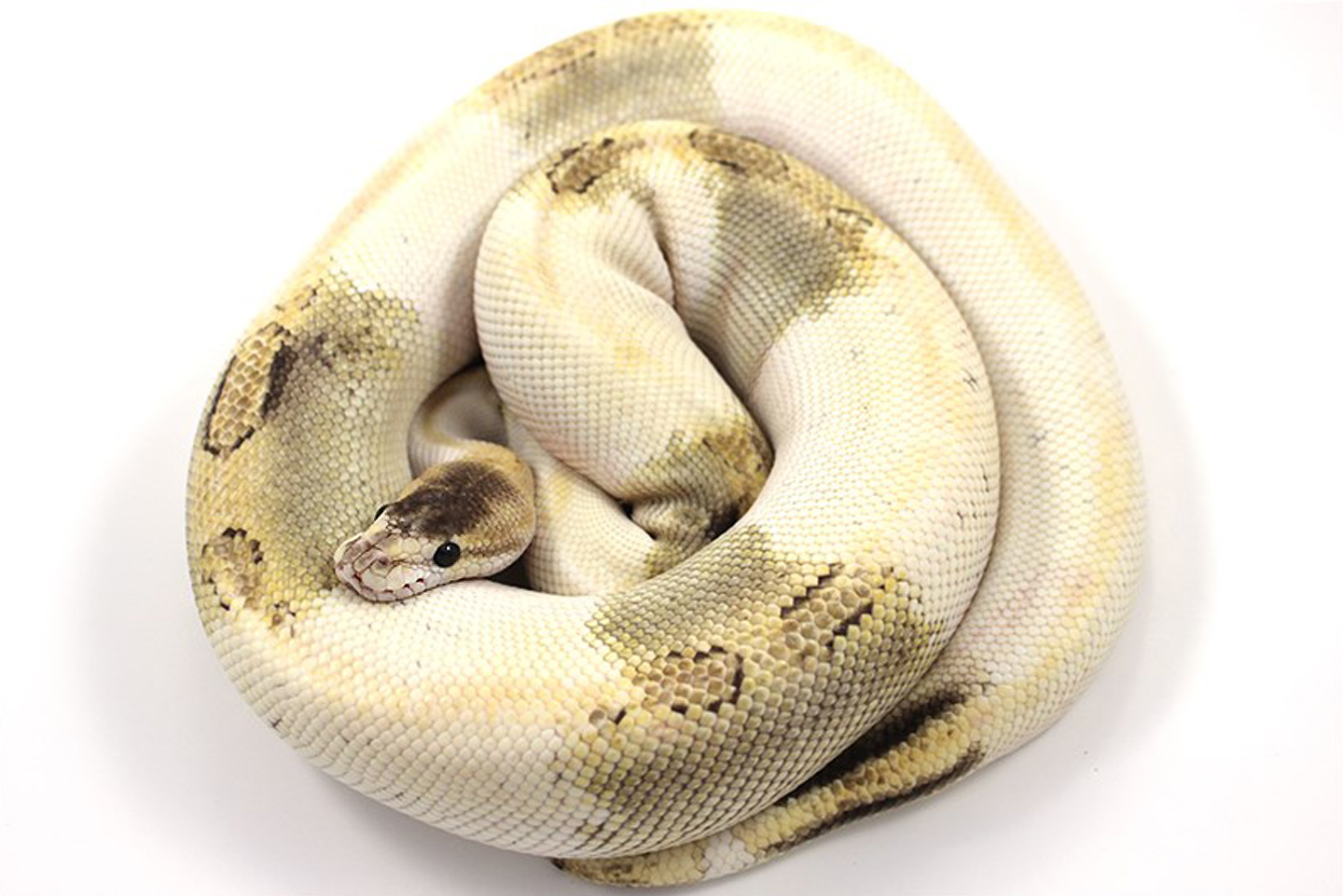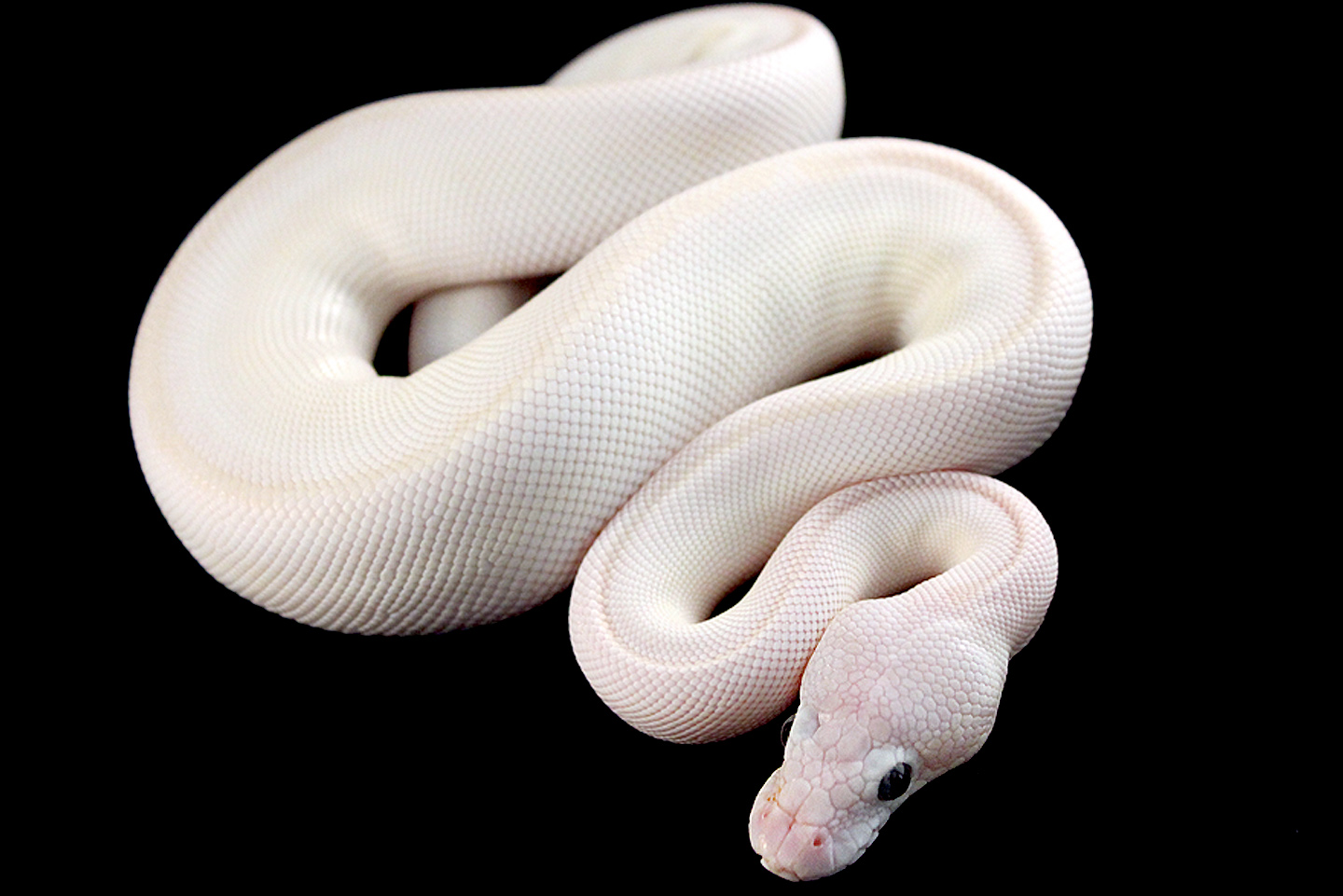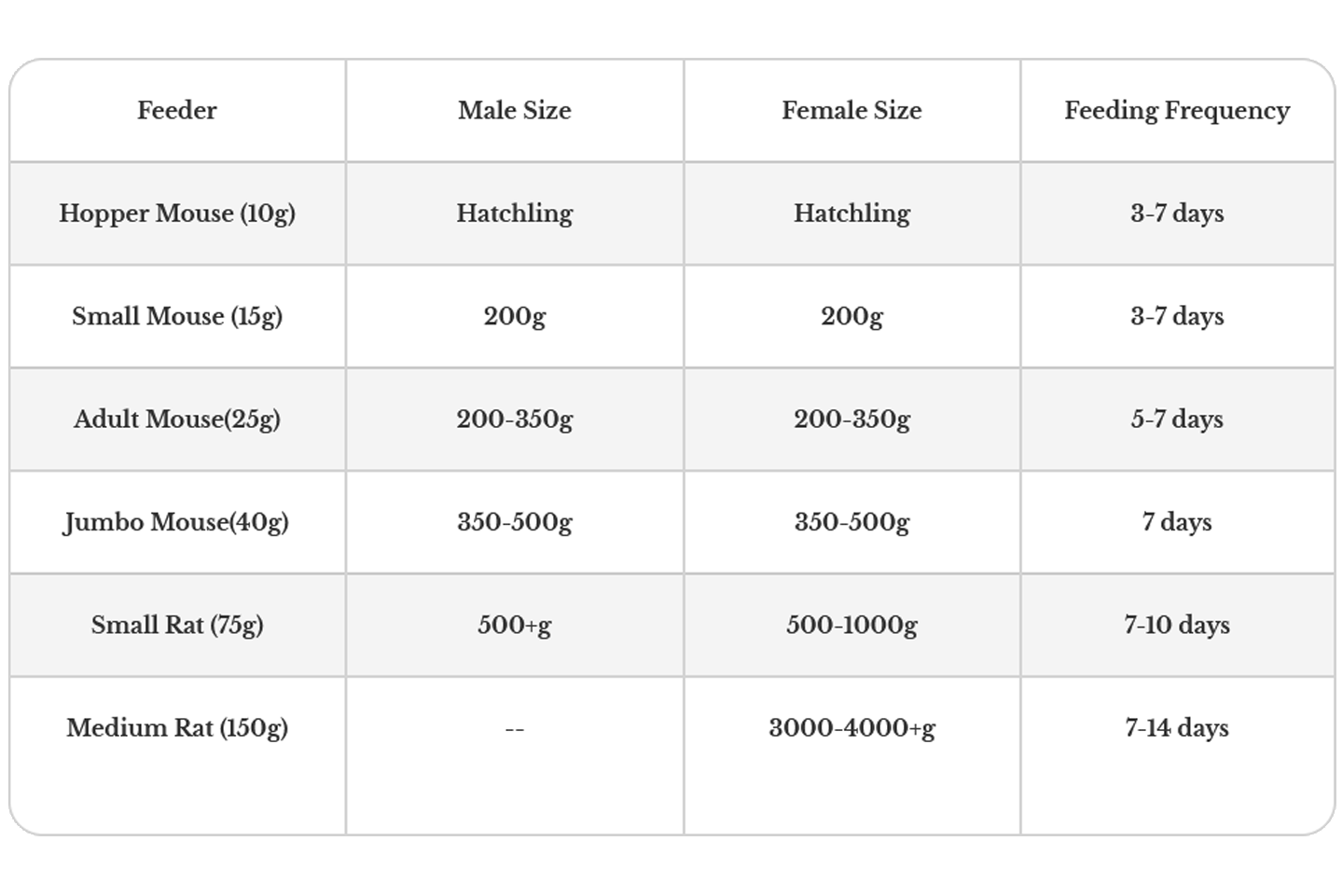A ball python caresheet, though the tips below could apply to a lot of beginner to intermediate species. The following is a short summary of care and resources I've figured out or found over the past 20+ years.
Ball Python Care 101
Housing Options ➤➤➤
Hides of All Sizes ➤➤➤
Substrate ➤➤➤
Heating Options ➤➤➤
Lighting ➤➤➤
Water ➤➤➤
Feeding Tools ➤➤➤
Frozen Food ➤➤➤
Feeding Size Guide ➤➤➤
Troubleshooting Common Issues
Stuck Shed ➤➤➤
My Snake Won't Eat! ➤➤➤
Clicks, Whistles and Bubbles ➤➤➤
Mites ➤➤➤
Vet Links ➤➤➤

Housing Options
There are a TON of cage options out there, from simple rack tubs to full blown automated rainforest cage systems. Both, and everything inbetween, are great options when managed correctly.
Baby ball pythons are often intimidated with full adult housing and may do better in a smaller tub before graduating into the full life-cage. If you move a baby into an adult cage and they stop eating, this might be why! Give them some time. If they continue to not eat (or if you want the larger cage to work), offer more hiding spaces/decor until they grow larger and more confident.
Both display cages and racks are available from Reptile Basics.
There is some debate regarding "rack systems", or keeping ball pythons in tubs. Through extensive research and firsthand accounts of people living in ball python native habitat, these animals prefer to live in found dens as ambush predators. This means that they don't dig their own burrows and tend to wait for food to come to them, only venturing out during mating season or when monsoons have flooded these holes and they need to escape.
We find our adults do best when kept away from our displays, and in large tubs with a hide depending on the individual.
The one cage type we don't recommend, is the classic aquarium with either clips or a sliding screen top. These cages are often the type snakes escape from as flimsy clips pop off, and cages are often too dry from the mesh top. On a particularly cold day, we've seen a glass cage shatter from a correctly placed heat pad (thermal fracture).
Hides of All Sizes
Two on either side of the cage, or one loooong one, or several, you can get creative with hides! Note that snakes love to be hugged and feel secure, so try to look for hides barely bigger than the animal and with only one main entry point.
AVOID hides with deep enclosed spaces you cannot access, such as hollow aquarium furniture. Snakes often get into these and either get lacerated on sharp plastic within, or stuck entirely with no way for the owner to rescue them.
We recommend checking out these hides to either order or get a feel for the ideal shape.
Substrate
Aspen, coconut bark/chips, paper towels, newspaper all work. Carefresh bedding usually in the small pet section also works, but can be a bit too dry for ball pythons.
AVOID pine bedding due to phenol content (this goes for all small pets).
We currently use coconut based substrate from Reptichip, which can be purchased online or often at reptile shows.
Heating Options
Heat one side of the cage, and keep the rest room temperature or a little warmer, so the ball python can move about as it wants. Snakes don’t make their own bodyheat so they have to regulate their bodily functions this way. The warm space should be roughly 90F for beginner snakes, with the ambient "cool side" anywhere between 70-80F.
There are several great options for heating:
Radiant heat strips: These are used in racks and are usually pre-installed for you. This is a long heated strip that goes along the back, or interwoven through the rear of tubs.
Radiant heat panels: These are roof installed panels that are used in display cages for overhead heat. Not ideal for ball pythons but an option and I like them a lot, these are installed in all our displays.
Under Tank Heaters (UTH): These are a classic, a heated pad placed on the back wall or under a cage.
AVOID heat rocks and unregulated heaters that come in very direct contact with a pet, this can burn them very easily as they have reduced nerve feeling along their belly and are likely not to wake up and move until it’s too late. Personally we also avoid heat lamps, as these often dry out cages, pose a larger fire risk and take up more space than radiant panels.
All of the above heating options require a thermostat to operate safely.
We recommend either using Vivarium Electronics or Spyder Robotics brand thermostats.

Lighting
Lights come in all shapes and sizes! We swear by LED strips made for aquarium use, so they won't get hot or immediately cause problems when humid. Also try to keep in mind how you will wire your light to keep snakes from getting tangled (we typically drill a hole immediately at the end of the light source so there's no wire distance for snakes to get hung up on).
Water
A standard waterbowl with fresh water should be provided at all times. Any catbowl, dogbowl or flat-based kitchenware are good options for this, though the heavier the better to keep the snake from tipping over the bowl and making a mess. There are also "fake rock" waterbowls, which may be an option but I personally find them to be a pain to clean thoroughly.
On the topic of water: ball pythons like it damp but not soaking in their cage. If you see mist on the cage constantly, it’s probably too much. If the snake’s belly scales feel like they’re dry and crinkly (this is hard to describe, but you’ll know it when you feel it), it’s too dry.
Typically a rack or display cage with no screen top isn’t going to be an issue, but you can mitigate problems by changing your substrate to something drier/damper, or providing a “humid hide” where you fill a hide box with wet sphagnum moss (people often buy a plastic shoebox and cut a hole in the lid for an easy enclosed space).
Or you can also mist the cage with a mister! I recommend a hand mister and not an automatic mister, as automatic systems often soak the cage immediately.
Personally, I keep our substrate hand-misted as needed, and the snake room has a humidifier (a godsend during dry winter months).
Feeding Tools
If you keep a snake for any amount of time, I recommend buying a sturdy pair of hemostats. These come in all shapes and sizes, which largely depend on your personal comfort level.
We tend to use hemostats between 12"-24". At this length it's easier to reach into a bag of thawed rodents, and not worry about getting tagged by a distracted snake with terrible aim.
Frozen Food
Someone once asked me if we took popsicle mice out of the freezer and simply handed them directly to our snakes.
There are many sources for frozen food items, whether at your local reptile show, online or at a local petsmart (though these are overpriced, they work in a pinch). Websites include RodentPro, MiceDirect, Layne Labs, Perfect Prey, and the list goes on.
There are equally a number of ways to thaw rodents. The best method that works for us is place the food in a ziplock bag, then heat it slowly with an electric heating pad. This brings the rodent up to temperature without soaking it in water, which can sometimes confuse a snake.
Ball pythons will typically not need tease feeding, but in case you come upon a particularly stubborn animal:
Feeding Size Guide
Typically your feeder size can be "the widest part of the snake". Here are some simple size guidelines to work with, but remember all snakes are individuals! Some animals will only eat smaller than usual feeders, some will be happy eating every other day if you let them. Find a feeding schedule that works for both you and your animals, and stick to it for the best success!

Troubleshooting Common Issues
Stuck Shed
The cage needs higher humidity, and/or a humid hide.
In the meantime, we typically soak a snake with stuck shed in a shoebox/container for an hour or so in tepid water (only filled up to halfway up the snake's sides). Often for minor issues, you can then take the snake out and gently roll off the shed piece with your fingers. If it doesn't readily slip off, continue soaking or wait until the snake sheds again and be sure to have humidity dialed in.
Poor sheds are sometimes caused by health issues, so if this continues to be a problem consider contacting a vet for a checkup.
My Snake Won't Eat!
This scares a lot of new people not used to snake metabolism. Especially new owners with new baby snakes that are in a new environment.
I try not to touch a new animal until it has eaten at least once in it’s new home. If a baby doesn’t eat for longer than a month, I suggest buying a live feeder that is on the small side of what the animal should normally eat. It's always easier to convert a snake from live onto FT than it is to get them eating in the first place.
Adults can roughly go for four months without concern. Keep an eye on their weight, and if they’re not dramatically losing mass, then there is little to worry about. Males in particular will shrug off eating for mating season.
Longer than a few months or signs of weight loss, and a vet should be contacted.
Clicks, Bubbles and Whistles
Now and then, a snake will click from shed clogging their nose, or accidentally blow a couple bubbles as you spooked them from drinking water. However, if these signs continue, it's time to check in with a vet! A respiratory infection or a virus could be the culprit.
Mites
Like kids with nits, sometimes snakes get mites. Typically these are simply an annoyance, though left unchecked mites can cause anemia and even death. We recommend stripping the animal's cage to paper towel and a waterbowl, and purchasing Provent-A-Mite.
To apply P-A-M, we typically spray paper towels in the garage the day before (well away from snakes and pets). This guarantees that the paper is dry the next day when we change the cage and put in freshly treated paper. Repeat this process weekly for a month or two to interrupt the life cycle and be sure all the mites are dealt with.
Vet Links
You need a reptile vet, and we're here to help!
Special thanks to Marla Blaney for compiling this information:
ARAV- The Association of Reptile and Amphibian Veterinarians: click HERE.
ABVP- The American Board of Veterinary Practitioners: click HERE, and choose the Reptile & Amphibian Category.
EBVS- European Board of Veterinary Specialisation: HERE, search for specialization in ‘Herpetological Medicine & Surgery,’ part of the ECZM.
ACZM- The American College of Zoological Medicine: HERE is the current diplomate roster. You may be able to find a vet in your area that sees companion animals (as opposed to working for a zoo.)
via Melissa Kaplan’s website Anapsid: HERE. (She discusses ways to find a Herp Vet HERE.)
Other resources HERE and HERE.
